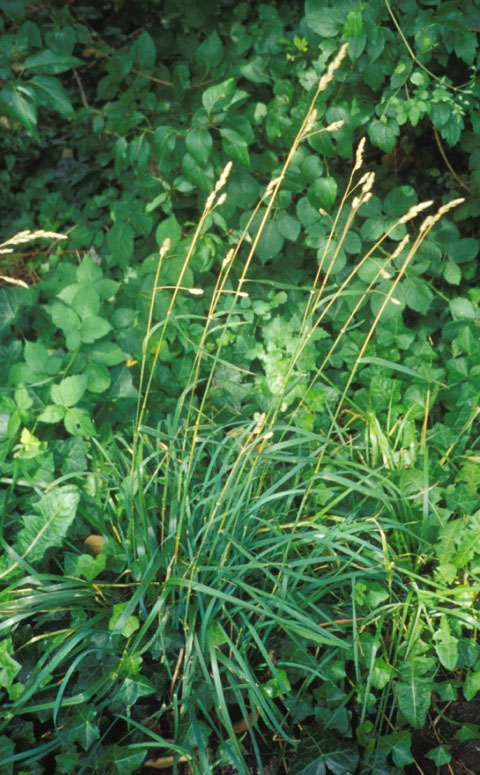
|
| Orchard Grass; Dactylis glomerata L. |
Grass Family; GRAMINEÆ (POACEÆ)
|
| At least 100 grass species grow wild in Greater Seattle, so it is no surprise that four have already caused enough trouble to be
included in this column. In fact, if the criteria for making the weed column were more directly related to true nuisance level, and less
slanted toward glamor, even more grasses would be featured here. Yet most of us, more captivated by color and fragrance than by
basic biology, prefer to learn the names of
conspicuous yet less common weeds; to hell with the various kinds of grasses. |
| In other words, even though Orchard Grass is far more common than many weeds treated already in these columns, it is
less sexy, and tends to be ignored as just another grass. It lacks the ubiquity of Annual Bluegrass, the tenacity of Quackgrass, the
shameless flaunting reproductive and growing abilities of Crabgrass, the viciously barbed seeds of Ripgut. You might say it is a
comparatively demure weed. "Excuse me," it apologizes, "I really don't
mean to be weedy. I'm terribly sorry" |
| Orchard Grass, like every other weedy grass in our area, is from elsewhere. In this case, from the Old World. It
was introduced before 1760 to the (future) United States, because it was useful for pasturage, for hay and silage, as a green manure,
and soil holder. But it ran wild and has spread throughout the continent. Not only does it seed effectively, but it can bear little
bulbils (small bulb-like organisms) to clone itself asexually. Since Orchard Grass is a perennial, it can produce generation after
generation. Although a mere clumper, not a riotous root-spreader (such as Quackgrass) it has advantages over Quackgrass and Crabgrass in that
it is shade-tolerant, and can thrive in almost all places except exceedingly wet ones. |
| Locally, it is common in many yards, parks, meadows, waste places, and nearly anywhere unmowed grass exists. It is
easy to spot in May when it is blooming. Look for a substantial clump of dark green grass with flowerstems reaching 2 to 4, or even 5
feet high. The name glomerata refers to its distinctively stout-clustered florets / seed-heads. The leaves are flat, sharp-edged, and
usually dull dark bluish-green. |
| As a large clump with a fast growth and ready aptitude to reseed, Orchard Grass has no role in ordinary yards. Don't let
it reseed, and uproot your specimens if you wish to banish it. |
The name Orchard Grass is American, and likely refers to this species being dominant in orchards. Other names,
more common in England, are Cock's-foot, and Dew Grass.
|
Originally published as the Seattle Tilth newsletter Weed of the Month in May 1994, along with an illustration from a book.
Back |
|
|

